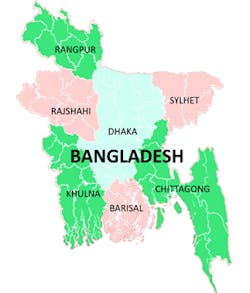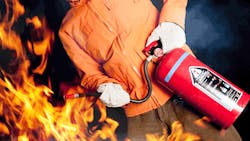More Than 100 Workers Die in Bangladesh Garment Factory Fire
The factory, Tazreen Fashions, is owned by Tuba Group and located outside of Dhaka, Bangladesh. Reports indicate that a lack of emergency exits and fire control contributed to the deadly conditions. Workers burned alive in the building or jumped to their deaths to escape the flames and smoke. Many others suffered burn or smoke inhalation injuries.
Initial reports suggest the fire was started by an electrical short circuit. Faulty wiring is the cause of over 80 percent of all factory fires in Bangladesh, according to the Clean Clothes Campaign, which works to improve conditions and support the empowerment of workers in the global garment industry.
Labor Groups Call for Action
As a result of the tragedy, the International Labor Rights Forum (ILRF) is calling for an independent and transparent investigation into the causes of the fire; full and fair compensation to be paid to injured workers and to the families of the deceased; and effective action from all parties involved to prevent future tragedies.
While there has been no official confirmation of the clothing brands produced at Tazreen Fashions, ILRF says evidence suggests this factory produced Walmart’s Faded Glory brand. According to ILRF, export data indicates that Walmart is the second largest buyer of garments from Bangladesh, after H&M.
More than 700 garment workers have died as a result of unsafe buildings in Bangladesh since 2005, according to ILRF research. This data, ILRF stressed, indicate a trend that brands can no longer ignore.
In March 2012, PVH Corp. (owner of Tommy Hilfiger, Calvin Klein, Van Heusen, IZOD, ARROW, G.H. Bass, and Eagle) signed an agreement with Bangladeshi unions, international unions, ILRF and other labor rights groups to develop a fire safety program to prevent future deaths in Bangladesh’s garment industry. The program includes independent inspections, public reporting, mandatory repairs and renovations, a central role for workers and unions in oversight and implementation, supplier contracts with sufficient financing and adequate pricing, and a binding contract to make these commitments enforceable. German retailer Tchibo joined the agreement in September.
Other brands implicated in large, deadly factory fires in 2010 – including H&M, Gap, JCPenney, Target, Abercrombie, Kohl’s and Carter’s – also have been invited to join the agreement. Gap Inc., however, apparently withdrew from fire safety discussions in October and announced their own program, which ILRF says “lacks central elements” of the aforementioned fire safety agreement.
“We hope the tragic fire at Tazreen will serve as an urgent call to action for all major brands that rely on Bangladesh’s low wages to make a profit,” said Judy Gearhart, executive director of ILRF. “Their voluntary and confidential monitoring programs have failed; now it is time to come together and make a contractual commitment to workers and to involve workers and their organizations in the solution.”
Death Traps
"These brands have known for years that many of the factories they choose to work with are death traps. Their failure to take action amounts to criminal negligence," said Ineke Zeldenrust from the Clean Clothes Campaign.
"As we yet again mourn the loss of scores of garment workers in Bangladesh, we demand that brands step up their game,” Zeldenrust continued. “Tragedy after tragedy underlines our belief that simple, cosmetic changes to existing programs simply aren't enough. Action needs to be taken to address the root causes of these fires.”
The employers and government of Bangladesh must also take their share of responsibility, the campaign added. The government must carry out an immediate investigation of the causes of the fire and prosecute those whose negligence has caused the death of these women and men. It must also invest in a countrywide program of inspections to ensure that the buildings currently in use are fit for purpose and the buildings and wiring meet safety standards. All factory owners in Bangladesh must immediately review the safety procedures in place at their factories, carry out checks on he building and electrical safety and, most importantly, start working with trade unions to train their workers on safety procedures and allow space for workers to voice their concerns, the campaign stressed.
An Extreme Risk
Bangladesh is the world’s second largest apparel exporter after China and has endured a reputation for poor occupational health and safety for workers within this industry. The Health and Safety Risk Index (HSRI) of 2010, which measures levels of risk to occupational health and safety in 176 countries, rated Bangladesh as an “extreme” risk.
In the 2010 EHS Today feature “Fashion Kills: Industrial Manslaughter in the Global Supply Chain,” Garrett Brown writes:
“The causes of these [Bangladesh garment factory] fires are well known to all involved — large quantities of poorly kept flammables, damaged and overloaded electrical systems and absent or completely inadequate fire suppression equipment.
“The latest major fire occurred Feb. 25, [2010], when 21 female workers were burned alive on the top floor of the Garib & Garib Sweater factory. The exit doors were locked. This tragedy occurred 99 years after the same scenario killed 146 garment workers at the Triangle Shirtwaist factory in New York City.”
To learn more about risks in the garment industry and in Bangladesh, see the related articles below.
About the Author

Laura Walter
Laura Walter was formerly senior editor of EHS Today. She is a subject matter expert in EHS compliance and government issues and has covered a variety of topics relating to occupational safety and health. Her writing has earned awards from the American Society of Business Publication Editors (ASBPE), the Trade Association Business Publications International (TABPI) and APEX Awards for Publication Excellence. Her debut novel, Body of Stars (Dutton) was published in 2021.


